► Phil McNamara reflects on the new Defender
► Behind the wheel of a 110
► The ultimate restomod?
Engineers say the urban jungle is the hardest environment for autonomous cars, with multi-directional traffic and a host of hazards from veering cyclists to random roadworks to a car door suddenly opening. But the actual jungle? It’ll be a piece of cake in comparison, if you’re driving the new Land Rover Defender that is.
We’re criss-crossing the forests, gravel tracks and muddy climbs of Eastnor Castle in Herefordshire, at the wheel of the 2020 Defender 110 (priced from £45,240). Admittedly Eastnor is a home fixture having acted as development hell for generations of Land Rovers, but the new flagship effortlessly glides over terrain to make lesser 4x4s tremble.
Read our Defender review
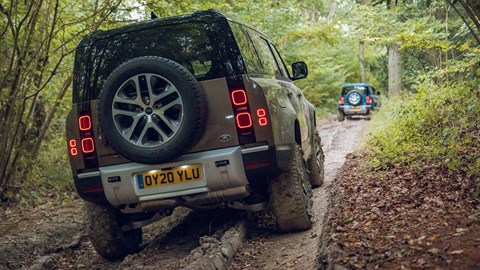
Meet the autonomous 4×4
Make no mistake, the off-road automaton is the one doing most of the driving. At times, I have my hands on the light, easygoing steering, but I know its position is totally out of whack with the oddball direction in which the front tyres are pointing. Yet the Defender continues to drive us forward in a resolutely straight line, while I try to get the steering angle to match up.
Activate Hill Descent Control and set 5mph as your downhill speed, and the 4×4 will crawl down at the prescribed rate while you win a game of dare by keeping your foot off the brake pedal. All the while you gently buck and sway in your towering seat position, thanks to the giving suspension.
Into the mud
At the outset we selected the low ratio gearbox for extra lowdown grunt, and the second highest of four air suspension settings, adding an extra 75mm of clearance. Now we’re choosing Mud and Ruts from the Terrain Response settings (a touch fiddly with the switches, so just press the icon on JLR’s new-generation touchscreen with much improved graphics). Ahead is the most challenging section: a narrow, muddy channel akin to traversing a bowl of porridge atop a table with two broken legs.

The grey slurry covers the Goodyear All Terrain rubber (these aren’t purely off-road tyres but for mixed use), and I’m thankful for the side cameras to help me avoid scraping the £840 Gondwana Stone metallic paint along the bank. In these gullies, I find these cameras more useful than the Clearsight Ground View, which assembles a view of the terrain obscured by the nose of the car. It would be helpful if we were clambering over rocky boulders though.
Into a sharp, slippery, downhill left-hander. I’m fearful that the tyres might lose their grip and the Defender slide helplessly sideways, just as I did off-roading a Mk3 Range Rover. Not today. Fleetingly I sense the electronic safety systems braking the rear-left wheel to aid traction (wheels can be locked within 150 milliseconds), but the Defender clings to its line resolutely. No drama, oh farmer.
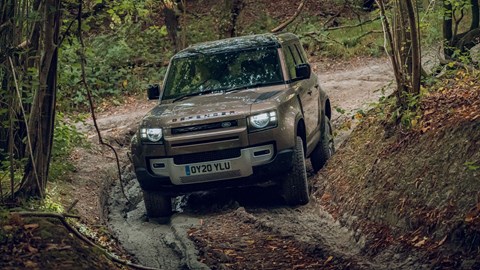
Sadly there’s no chance to test Terrain Response’s new sixth setting, for wading. Sonar can monitor the depth of the water you’re fording, and cope with up to 900mm of the wet stuff (more than any other 4×4 on sale). Today’s off-roading barely scratches the surface of the new Defender’s capability (though the overhanging branches do their best to scratch the paintwork). After all, Land Rover says the new Defender is the toughest, most capable SUV it’s ever engineered.
And onto the tarmac
It’s also very capable on road, in a way its iconic predecessor could only dream of. The steering is light and responsive, immediately triggering the contrasting memory of driving the Rugby World Cup Defender back in 2015, where I scrummaged with the old car’s heavy and ponderous steering to the bemusement of my passenger, Rugby World Cup winner Jason Robinson.
The new Defender 110’s air-suspended ride feels relaxed and extremely comfortable, generating some progressive lean through corners; the original Land Rover would bounce and roll in a most ungainly fashion. And the brakes are so sharp they take some getting used to; in the original they were just plain blunt.
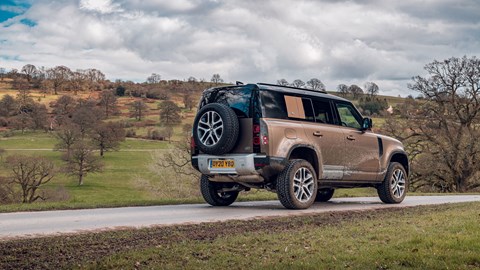
On the motorway you can now hear yourself think, with wind noise remarkably pared back considering the frontal area and just the underlying hum of the D240 diesel for company. It revs smoothly but is garrulous under heavy load. Everything has been finessed in the wind tunnel, from the optional snorkel integrated into the windscreen pillar to the chamfered side cargo boxes.
The 237bhp diesel delivers adequate performance – 9secs from stop to 62mph – though that’s still SIX seconds quicker than its 2.2-litre turbodiesel forebear. While the eight-speed automatic transmission responds smartly to kickdown, you’ll need a decent stretch for overtaking. Hardly surprising in a spacious, all-wheel drive vehicle that weighs at least 2.2 tonnes, more with myriad accessories and packs and an optional locking rear diff to funnel power to the wheel with most traction when off-road. All of which ratchet up the price: the test car is £64k, with options including black roof, £2625 20-inch rims, electric tow bar and a couple of grand of off-roading kit.
The ultimate restomod
The Defender is the third reincarnation of famed 4x4s, following the reborn Jeep Wrangler and Mercedes G-class. Car’s latest issue has the first comparison test of the three, all of which have bucketloads of charm. But while the Jeep and Mercedes play-it-safe by being painstaking facsimiles of what’s gone before (both in design terms and their body-on-frame chassis), the Defender takes the essence of the original Land Rover and successfully future-proofs it.
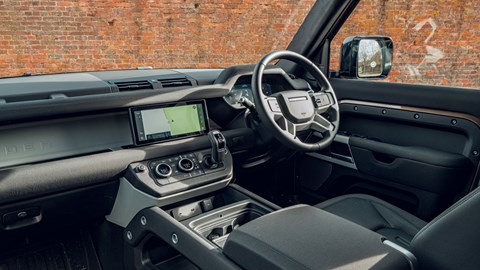
The chassis is an aluminium-intensive monocoque, which Land Rover claims offers three times the rigidity of a ladder-frame design: you immediately notice the superior refinement and sharper handling from the lower centre of gravity. The technology feels very leading edge, with connected features such as suggesting parking spots at your destination and over-the-air software updates, and surround cameras to compile pin-sharp images of your surroundings. Technical details of a plug-in hybrid will soon be announced; good job as the diesel engines’ carbon emissions and fuel consumption are unsatisfactorily high (rated at 199g/km of CO2 and 37mpg).
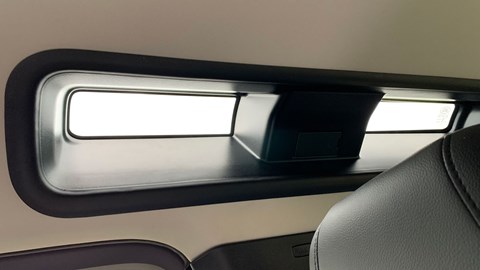
Ultimately all this tech and driveability is wrapped in a brilliant piece of design. The iconic two-box silhouette is there, even riding on steel wheels should you wish, but with the chunky charm of the indestructible-looking Tonka Toys I loved as a kid. Layer on ultra-cool details such as the glowing rings of the rear lamps, the body coloured square interrupting the glasshouse and the ultra-confident single bar grille, and you have a splendid fusion of old and new.
The interior is even more pleasing, Land Rover’s best since the Mk3 Range Rover’s. There’s something of the Norman Foster school of industrial design in the magnesium beam that runs across the dash, mixing the structural and the aesthetic, with extra function baked in as a storage shelf and mounting point for the grab handles and touchscreen. There are exposed screw heads, flashes of exterior body colour, plastic floor mats covering a plastic floor and Alpine skylights above the rear seats. Plus little features to delight your inner adventurer: a boot with optional 3-pin plug socket and ride height toggles to make hitching your trailer simple.
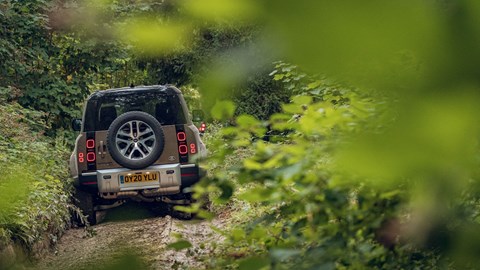
So the new Defender does it off-road. And on-road. It marries the spirit of yesterday with a contemporary design and technology fit for tomorrow. It’s the ultimate restomod, and I found it pretty irresistible.